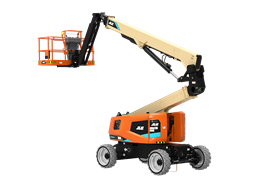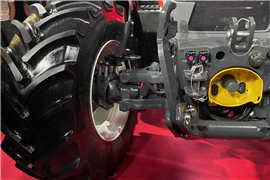Read this article in Français Deutsch Italiano Português Español
State of on-highway electrification: Market drivers
08 May 2024
North American growth in commercial EVs will hinge on incentives and lower TCO
 Most commercial vehicle OEMs and their suppliers are playing the long game when it comes to electrification. (Photo: Danfoss Editron)
Most commercial vehicle OEMs and their suppliers are playing the long game when it comes to electrification. (Photo: Danfoss Editron)
(Editor’s Note: In this first part of a series on the State of On-highway Electrification, we look at the market for commercial electric vehicles and where it’s heading.)
Hundreds of models of commercial electric vehicles (EVs) have emerged on the global market in recent years as suppliers seek to capitalize on a pending surge in demand for low- and zero-emission on-highway solutions. Yet, the take rate for these vehicles has yet to reflect that surge.
 Eric Azeroual, vice president of On Highway, Danfoss Editron
Eric Azeroual, vice president of On Highway, Danfoss Editron
In 2022, the International Energy Agency (IEA) reported nearly 66,000 electric buses and 60,000 medium- and heavy-duty electric trucks sold worldwide, representing 4.5% of total bus sales and 1.2% of total truck sales globally. Of those sold, 80% of trucks and 85% of buses remained in China where they were produced.
“Obviously, electrification is happening at different rates around the globe, mostly led by China because they started this a long time ago and they have a pretty good hold on the supply chain,” said Eric Azeroual, vice president of On Highway for Danfoss Editron. “The electrification rate is then followed by Europe – highly pushed by government policies in different cities – and then the U.S., led by a big portion in California to reduce emissions there.”
Across North America, the numbers hardly reflect a burgeoning market. “If you look at 2023 production data for Class 3 to Class 8, the take rate is still very, very low,” said Thomas Heck, key account manager for heavy-duty customers in the Regions Americas at Schaeffler. “In total, there are about 630,000 vehicles that were produced in North America in that class range, and out of those 630,000, less than 6,000 are battery electric. You add a few hundred fuel cell vehicles on top of that and you’re still at less than 1% of the overall market.”
The long game
Most commercial vehicle OEMs and their suppliers are playing the long game when it comes to electrification. While he estimated less than 5% of medium-duty and less than 2% of heavy-duty vehicles built in a year in North America are currently EVs, Shaun Twomey, global market & sales lead for ZF’s Commercial Vehicle Solutions division, expected that to change dramatically within the next few years.
“If we were to zoom out and look at, let’s say, 2030 and put a stake in the ground there, we would say that electrification rate for medium-duty vehicles built jumps to almost 30%, and for heavy duty a bit shy of 20%,” he projected. “To go from relatively low electrification rates today to meaningful rates in what would be six years’ time, I think is a pretty interesting trajectory.”
Even if the EV build rate in 2030 is more in the 15% and 5% range, respectively, as Azeroual said Danfoss anticipates, it is still a marked growth from current levels, which he placed at roughly 2% for medium duty and less than 1% for heavy duty. He added that heavy duty may reach as high as 10% by 2030, depending on the charging infrastructure to enable it.
 Thomas Heck, key account manager for heavy-duty customers in the Regions Americas, Schaeffler
Thomas Heck, key account manager for heavy-duty customers in the Regions Americas, Schaeffler
“We’re really at the beginning of this,” he said, “and it’s interesting to see how this will develop.”
Medium duty leading the way
According to Heck, there are certain vehicles for which it’s much easier to adopt a zero-emission strategy than others. “This has to do with the type of vehicle, the size of the vehicle, the weight it has to transport, the distance that it has to travel,” he said. “And then the use case is how much access does that vehicle have to charging opportunities?”
“Knowing what we know about electrified vehicle performance and their limitations today, we would say that medium-duty vehicles and/or those which come back to ‘home base,’ if you will, on a regular basis – those tend to be very naturally suited toward electrification,” Twomey said.
Heck agreed, adding, “It’s a truck that returns once or multiple times a day back to its home base, back to the depot, where it can go on a charger. That’s the type of application that really makes sense to electrify first.”
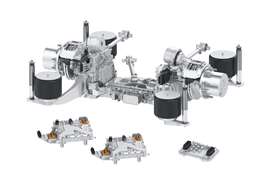 AxTrax 2 LF (Low Floor) designed for transit bus. The low floor design allows for passengers to walk through the low aisle-way and not have an axle creating a hump in the middle of the aisle or having to step up, ZF noted. (Photo: ZF Group)
AxTrax 2 LF (Low Floor) designed for transit bus. The low floor design allows for passengers to walk through the low aisle-way and not have an axle creating a hump in the middle of the aisle or having to step up, ZF noted. (Photo: ZF Group)
School buses and urban delivery vehicles are expected to lead the North American commercial EV market. “If you look at a school bus, it typically is the same route and it’s predictable. Same goes with medium-duty delivery trucks or urban trucks. They typically do predictable routes, and they don’t travel more than 200 miles a day,” Azeroual noted. “Those are going to be the easy ones to electrify… because of the range.”
This 200-mile “sweet spot” applies to a variety of vehicles, such as Class 4 and 5 step vans, delivery vehicles, yard spotters and more. “Based on the math – the total cost of ownership (TCO) and the rebates and incentives that are out there – a wide variety of those kinds of vehicles can go electric today with this kind of scenario and pay off,” Twomey said.
Even heavier-duty vehicles such as refuse trucks, with their limited and predictable routes, are proving viable candidates for electrification. “If you think about where these vehicles are being used (residential areas), school buses, refuse trucks – that absolutely makes sense to go to a technology that has zero tailpipe emissions,” said Heck.
“The limitation today to getting more electrified commercial vehicles is the charging infrastructure,” said Azeroual. “If you have a 200-mile truck, you roughly have a 250-kWh battery. That means that with a charger of 22 kW, you can charge that vehicle overnight at a decent rate and at a decent cost. The trouble in going above that is how are we going to charge these vehicles, how much is it going to cost in terms of charging infrastructure and who’s going to pay for that?”
Such questions make it harder to justify an investment in Class 7 and 8 EVs. “The good news though is… even though these kinds of limitations exist today for heavy duty in certain respects, they’ll still play a role in 2030,” Twomey said. “But much less so.”
 Shaun Twomey, global market & sales lead, ZF Commercial Vehicle Solutions
Shaun Twomey, global market & sales lead, ZF Commercial Vehicle Solutions
TCO compared to ICE
Currently, TCO calculations for commercial EVs are a mixed bag, largely due to the substantially higher purchase price compared to traditional vehicles.
“It’s hard to justify the investment in a battery-electric vehicle right now. There’s a lot of upfront cost,” said Heck. “Fleet operators are in the business of making money, maximizing profits, so they need to see how they can offset the higher upfront cost of the battery-electric vehicle.”
Costs have been exacerbated by inflation and the resulting high interest rates. Supply constraints are also a factor, with batteries and their key components largely coming out of China.
“These vehicles are more expensive to buy in the first place, so it’s become harder to convince customers to put in the capital to buy these trucks because of the interest rates,” said Azeroual. “And then they need to have the charging infrastructure on top of that, which is also capital intensive.”
“The good news is for many commercial vehicles – usually in the lower classes and for certain applications that come back to a home base frequently – that TCO is already compelling compared to ICE (internal combustion engines),” Twomey asserted.
“There’s a good business case for those vehicles in terms of return on investment, including the maintenance cost,” Azeroual said. “EVs have very low maintenance cost compared to traditional vehicles. And of course, historically gasoline prices are more volatile and subject to geopolitical events. Annualized electricity costs tend to be more stable than gas prices.”
“In general, electricity is cheaper than fuel, so there’s a certain benefit there,” Heck agreed. “There will also be an advantage on the maintenance cost. Simpler architecture and fewer moving parts require less maintenance.”
“At the other extreme, if you look at something like a heavy-duty Class 8 long haul or regional tractor, that’s a little more challenging to electrify today and have the math work out,” Twomey noted. “The TCO today for that kind of deployment is a little challenging.”
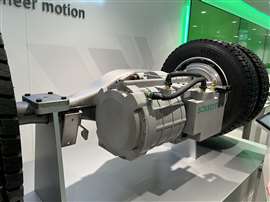 “Once you get to that TCO parity between battery-electric and diesel trucks, that’s when we will get into a situation where everything becomes self-sustaining,” said Schaeffler’s Thomas Heck. Shown is the company’s rigid beam 3-in-1 e-axle. (Photo: KHL staff)
“Once you get to that TCO parity between battery-electric and diesel trucks, that’s when we will get into a situation where everything becomes self-sustaining,” said Schaeffler’s Thomas Heck. Shown is the company’s rigid beam 3-in-1 e-axle. (Photo: KHL staff)
Yet, there is still a TCO argument to be made. “If you were to operate a classic long-haul truck today, you’re probably staring north of $200,000 over the life of that tractor in maintenance cost,” Twomey estimated. “We have every reason to believe that with an electrified powertrain your maintenance costs [will be] 20%, 30%, even 40% lower… That’s nothing to sneeze at.”
He foresees coming to an inflection point at which larger size classes of electrified vehicles will start to make sense over diesel. “If we look at, say, a regional Class 8 application, we would see the inflection point for TCO tipping from ICE today to electrify probably in the late 2020s – so 2027-28, somewhere in there. For a local Class 8, a couple years before that,” Twomey said.
Heck believes, “Once you get to that TCO parity between battery-electric and diesel trucks, that’s when we will get into a situation where everything becomes self-sustaining. That transition will pick up pace [to where] there’s enough inertia behind it then to really drive this forward.”
For medium-duty vehicles, such as Class 4-5 delivery or step vans, conditions are already becoming more favorable today. “That’s not to say it’s as easy as buying the BEV step van and being done with it,” Twomey acknowledged. “But I think it’s encouraging that for many of these vehicles and applications already in the industry, electrification makes sense.”
Incentives matter
In some scenarios, the availability of government incentives can help to bring acquisition costs more in line with traditional vehicles.
“We shouldn’t rule out how important those are at this point, whether that’s IRA (Infrastructure Reduction Act) tax credit for commercial vehicles [or] incentivizing putting charging infrastructure in place,” said Heck. “That will help to bring the long-term costs down.”
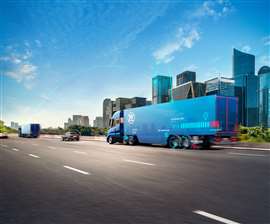 It’s important for fleets to look to others in the value chain for help in navigating government incentives for electrification, said ZF’s Shaun Twomey. (Photo: ZF Group)
It’s important for fleets to look to others in the value chain for help in navigating government incentives for electrification, said ZF’s Shaun Twomey. (Photo: ZF Group)
Where the IRA offers a purchase tax credit of up to $40,000 for the largest vehicles and a tax credit of up to $100,000 per charging station, California’s Hybrid and Zero-Emission Truck and Bus Voucher Incentive Project (HVIP) offers vouchers up to $150,000 toward purchase of qualifying zero-emission vehicles.
“When you look at an electric school bus, that’s significant,” said Azeroual. But with e-buses selling for around $350,000, they’re still much more expensive compared to conventional ICE school buses. “The reason it works in the school bus industry is because they’re nearly fully subsidized. At the federal level, the Clean School Bus Program provides incentives for replacing diesel buses with electric ones. It offers up to $375,000 per bus for the replacement and an extra $20,000 for charging infrastructure, making this a no brainer for the schools and bus operators.
“If you look at a heavy-duty electric truck, $150,000 is still a lot of money, but is that really going to offset the price premium that the customers have to pay for it?” he questioned, citing an unpublished price estimate of $500,000 to $600,000, though prices are expected to vary by manufacturer.
“Electrification is such a complex and new territory for all of us. If I’m a fleet owner, it’s difficult to get my arms around the universe of incentives and rebates out there,” Twomey commented. “I can certainly see many fleets who see that as so challenging and complex and mysterious that they just throw up their hands and say, ‘You know what, I’m going to stick with diesel.’ And I certainly understand the motivation for that.”
However, he encouraged fleet owners, and their suppliers, to get the conversation started. “It’s really important for fleets to look to others in the value chain for help with that,” Twomey emphasized. “Whether it’s the local utility, their OEM partner, or ultimately that OEM’s partner – a Tier 1 like ZF – all these players have a role to play and are eager to play it in helping fleets understand ‘Here’s the layout of incentives that you can take advantage of at the federal level or the state level. Here’s what’s coming in terms of infrastructure needs for your local utility. And here’s what you need to start talking to them about to have your site built out appropriately for chargers.’
“I think those kinds of conversations can really help put a fleet’s concerns somewhat at ease as they start to dip their toe into electrification.”
|
POWER SOURCING GUIDE
The trusted reference and buyer’s guide for 83 years
The original “desktop search engine,” guiding nearly 10,000 users in more than 90 countries it is the primary reference for specifications and details on all the components that go into engine systems.
Visit Now
STAY CONNECTED




Receive the information you need when you need it through our world-leading magazines, newsletters and daily briefings.
CONNECT WITH THE TEAM












